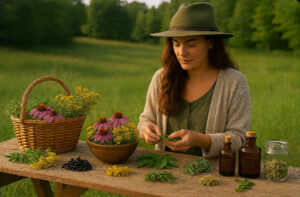Late Summer Apothecary
Medicinal Herbs to Harvest Now in South-Central Pennsylvania

Image by Kathy McCabe and Copilot
A reference-backed guide for herbalists, homesteaders, and wellness seekers
As September unfolds across the hills of South-Central Pennsylvania, the land offers up a quiet abundance. For herbalists and wellness seekers, this is a season of gathering—of roots, leaves, flowers, and berries that have soaked up the summer sun and are now ready to be transformed into healing remedies.
Here are seven medicinal plants currently at their peak, with sources to guide your harvest and deepen your practice:
1. Echinacea (Echinacea purpurea)
- Where to find it: Meadows, gardens, cultivated beds
- Parts to harvest: Flowers and leaves now; roots later in fall
- Uses: Immune support, antiviral teas, tinctures
- Harvest tip: Snip blooms when fully open. Dry upside down in bundles.
- Sources:
- Gardening Know How explains how to harvest flowers, leaves, and roots for teas and tinctures.
- Garden Therapy details echinacea’s immune-boosting properties and traditional use.
2. Goldenseal (Hydrastis canadensis)
- Where to find it: Shady forest understories
- Parts to harvest: Roots (only if cultivated or sustainably wildcrafted)
- Uses: Antibacterial, digestive aid, topical salves
- Harvest tip: Wait until senescence in fall for highest alkaloid content
- Sources:
- Penn State Extension outlines cultivation and ethical harvesting in Pennsylvania
- A 2019 study confirms alkaloid levels peak at senescence, supporting fall harvest timing.
3. St. John’s Wort (Hypericum perforatum)
- Where to find it: Roadsides, open fields
- Parts to harvest: Flowering tops
- Uses: Mood support, nerve pain, infused oils
- Harvest tip: Harvest mid-morning on sunny days when flowers are fully open
- Sources:
- ShunCy offers harvesting guidance and medicinal uses
- Ready Nutrition provides tincture preparation tips.
4. Yarrow (Achillea millefolium)
- Where to find it: Meadows, garden edges
- Parts to harvest: Flowers and feathery leaves
- Uses: Wound healing, fever reduction, digestive support
- Harvest tip: Gather in full bloom. Dry flat to preserve flower heads
- Sources:
- JohnysFarm explains identification, harvesting, and drying techniques
- Almanac.com shares historical and medicinal context.
5. Elderberry (Sambucus nigra ssp. canadensis)
- Where to find it: Hedgerows, stream banks
- Parts to harvest: Ripe berries
- Uses: Immune-boosting syrups, teas, tinctures
- Harvest tip: Only harvest fully ripe, dark berries. Cook before use to neutralize toxicity
- Sources:
- PA Eats details foraging and preparation in Pennsylvania
- Gardener’s Path covers medicinal uses and preservation.
6. Plantain (Plantago major)
- Where to find it: Lawns, trails, disturbed soil
- Parts to harvest: Broad leaves
- Uses: Skin healing, insect bites, poultices
- Harvest tip: Pick vibrant leaves anytime; seeds in late summer
- Sources:
- Farm and Dairy outlines uses for burns, bites, and internal inflammation
- Reality Pathing explains optimal harvest timing.
7. Basil & Oregano (Ocimum basilicum & Origanum vulgare)
- Where to find it: Cultivated gardens
- Parts to harvest: Leaves
- Uses: Antioxidant-rich culinary and medicinal herbs
- Harvest tip: Pinch back regularly to encourage growth. Dry or freeze for winter blends
- Sources:
- The Garden Magazine offers September harvesting tips
- The Gardening Dad lists basil and oregano as top medicinal herbs for Pennsylvania gardens.
Crafting Your Seasonal Apothecary
Harvesting is a ritual—a moment to connect with the land, to listen, and to give thanks. Whether you’re drying herbs for winter teas, infusing oils for topical blends, or preparing tinctures for your herbal cabinet, each plant carries the story of the season.
Happy Harvesting! Kathy

Kathy is an herbalist/naturopathy practitioner who is constantly researching to expand her knowledge. She came to herbalism after her migraine medicine was suddenly removed from the market and she had to find something new. After discovering the magic of herbs she’s never looked back. She is accredited by the International Practitioners of Holistic Medicine (IPHM) and is an Associate Member of the American Herbalist Guild.
